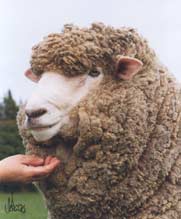Guide to Judging and Selection of Corriedale Sheep
The aim of judging Corriedales should be to select the animal with the genetic breed values and attributes that will increase the profitability of the breed.

 Initial Appraisal
Initial Appraisal
1. Judging starts by standing well back to take an overall assessment of the sheep. The sheep should have good size, conformation with characteristics, which denote a strong constitution. These characteristics should incorporate length and depth of body a good spring of ribs (giving width), leading to a big- framed, robust sheep. The body should be well covered with wool extending down the legs and an even cover on the head.
2. Approach the sheep, with your knees against its side to steady it, examine the mouth. The jaw and bite should be broad. The teeth should be well formed and should meet the pad squarely. The teeth should not overshoot or undershoot the jaw.
3. Examine the eye and the ear. The eyelids should be free from excess pigment and the lashes should be white and not turned in. The ears should be white and thick.
4. Examine the horn bases. A depression with no sign of horns. Also check there are no coloured fibres in the horn depression.
Wool
 The Corriedale carries a heavy, even, well nourished bright fleece of good quality wool. The wool should have a long dense staple, pronounced crimp, soft handle and an even tip. For visual appraisal purposes, the object quality should be within the range of 50 - 58's, spinning count (25 to 30 micron) and emphasis must be placed on quality.
The Corriedale carries a heavy, even, well nourished bright fleece of good quality wool. The wool should have a long dense staple, pronounced crimp, soft handle and an even tip. For visual appraisal purposes, the object quality should be within the range of 50 - 58's, spinning count (25 to 30 micron) and emphasis must be placed on quality.
5. Check the wool on the poll, which should have crimp and be free from kemp. The wool on the back of the neck should be dense and of the same strength as the body wool.
6 Inspect the wool on the shoulder; staying to the side of the back line, as opening the wool in the middle of the back could leave the fleece susceptible to weather damage.
7. Open the wool from the shoulder, well down towards the knee, looking for length style and handle.
8. Go to the rump. The wool should have even character, length and density.
 9. Examine the wool over the base of the tail for evenness.
9. Examine the wool over the base of the tail for evenness.
10. Check the flank. A sound sheep should show no sign of fining off or plainness along the midribs from top line to belly.
11. Go down the thighs where the wool should be even and as full of character as the rest of the wool, although a slight tendency to strengthen in this region is not to be discriminated against. There should be no sign of roughness.
12. Important: Always close up the wool after inspection. It is also important to know how to open up the wool correctly.
13. The fleece should be dense and well nourished which gives the ability to shed dust and water.
Conformation
 14.The neck should be of a good medium length and fit squarely on the shoulders. The ribs should be well sprung and come from a straight broad back.
14.The neck should be of a good medium length and fit squarely on the shoulders. The ribs should be well sprung and come from a straight broad back.
15.The rump should be broad and in line with the topline of the rest of the back.
16. The tail setting should be high and the rump should not drop towards the tail.
17. The hind quarters should be deep broad and well muscled.
18.Turn the sheep over and feel the legs for bone conformation. Examine the hoofs, which preferably should be dark.
19.The testicles of the ram should be well developed, pliable and large. The ewe should show evidence of good teat and udder formation.
20.The belly should be well covered with wool of a good length and the same strength as the wool elsewhere on the body. There should be no sign of a weakening or fining down (fribby) of the wool count, especially where the belly wool joins the body wool.
21.The wool on the legs should be white and free from coloured fibres.
Final Assessment
If practical allow the sheep to walk away from you. When viewed from behind, the legs should be straight and well apart, with no sign of hockiness. Watch the sheep walk towards you. The front legs should be free from twisted joints and fallen pasterns. The sheep should stand on all four legs and feet and have a good outlook, with the head naturally held high and giving the impression of a well-finished animal.
The sequence demonstrated here has been designed to give a basic guide for judging Corriedale sheep. Experienced judges have varying techniques for appraisal, but this illustrated sequence will give a logical system for assessment.
